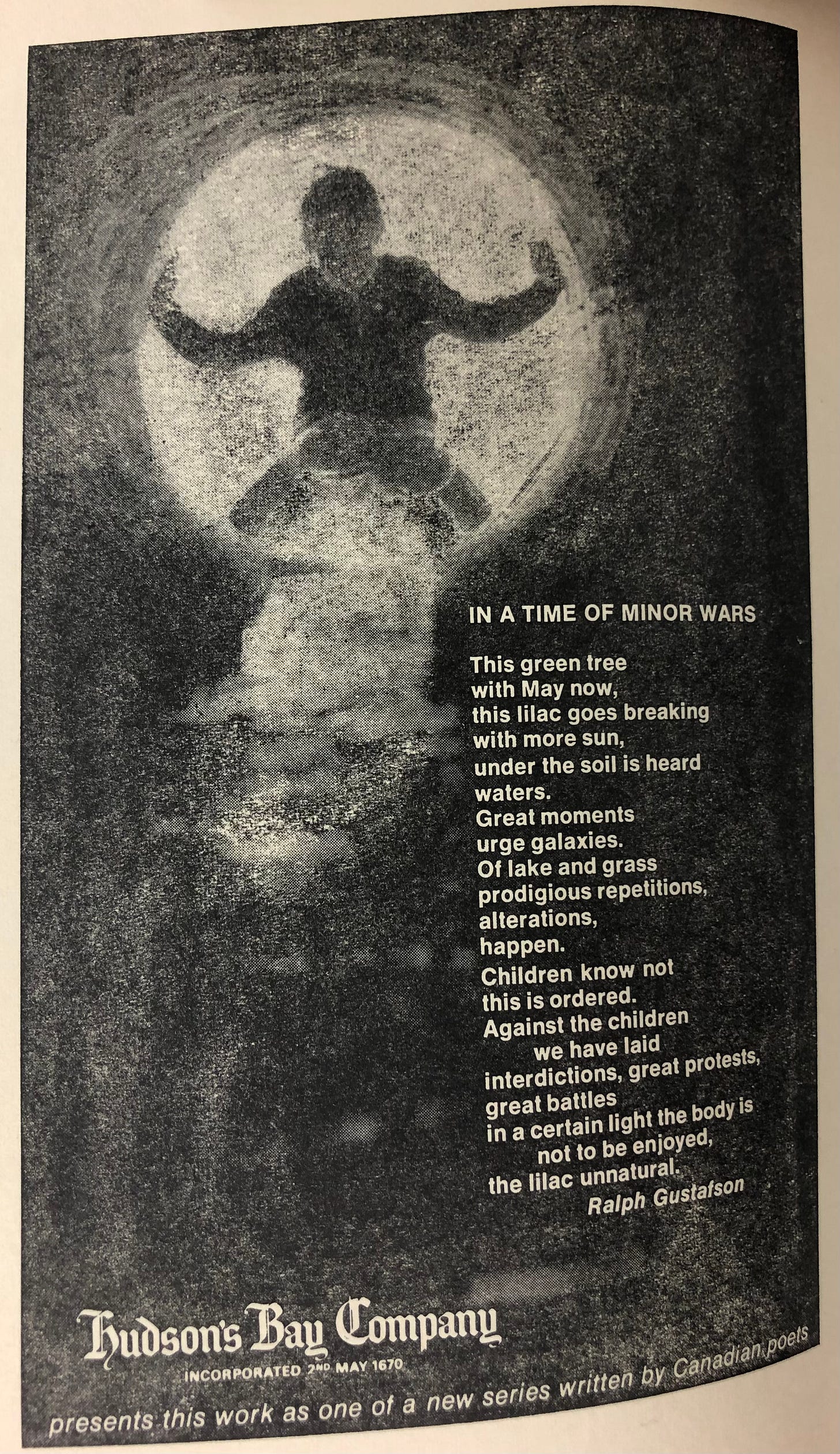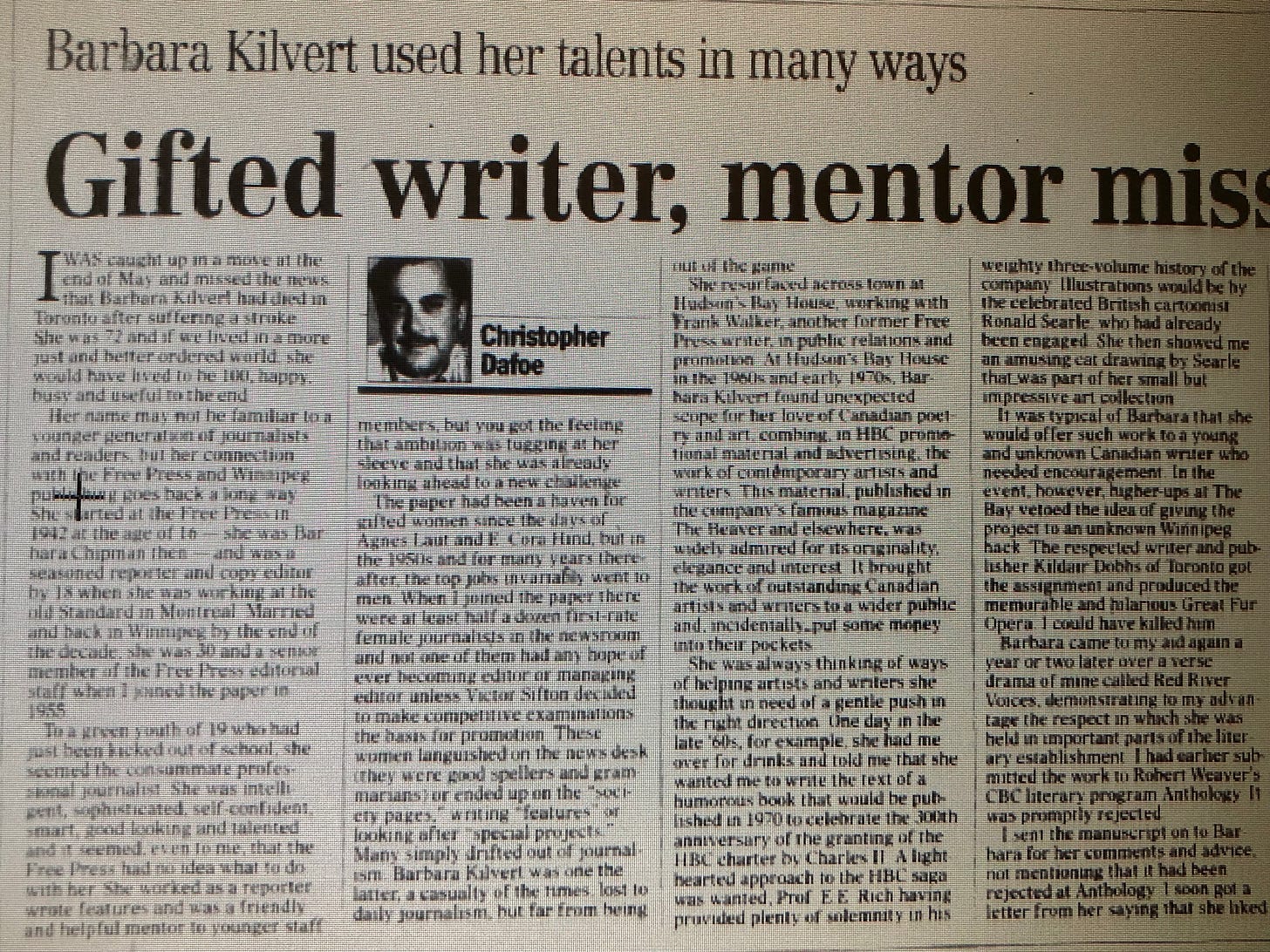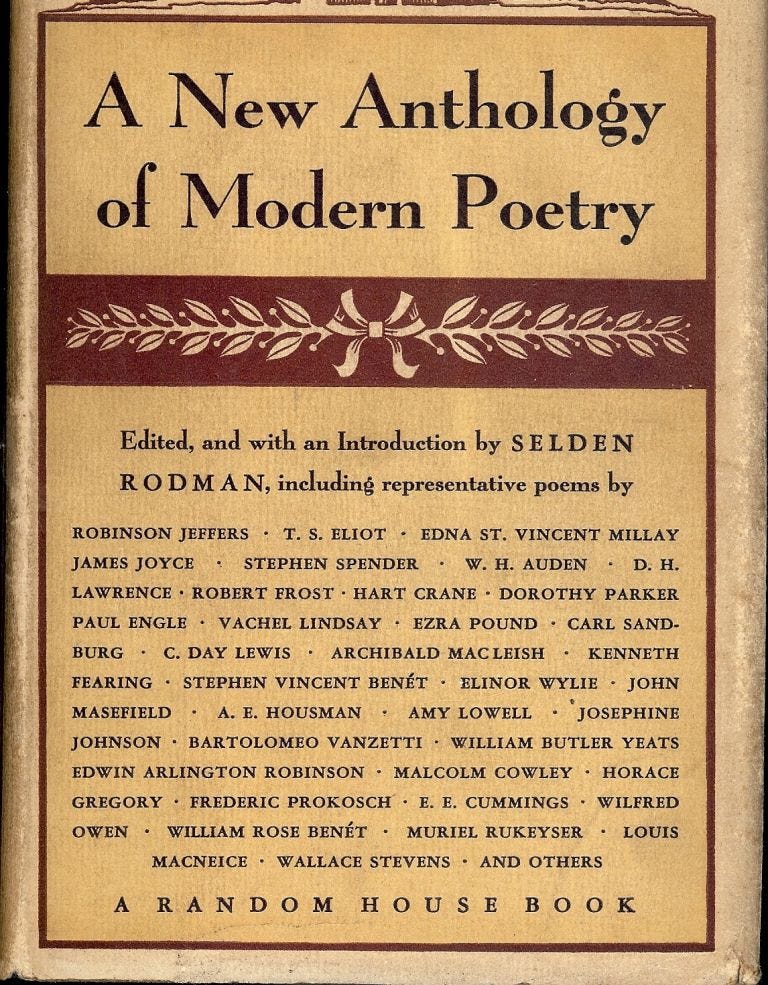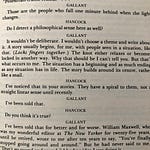WAIT!
STOP!
ACHTUNG!
Before you click on the arrowhead above to hear today’s interview with Ian Kilvert —
— take a moment to read these few preliminary notes; they will be useful background.
Ian Kilvert — who so gamely and (ahem) gallantly agreed to talk to me about his family’s, especially his mother Barbara’s connection to Mavis Gallant (MG) — and I are the same age, both grew up in Winnipeg; we’ve never met, but he feels familiar, somehow, as people who are relative strangers will when, from infancy, they breathed the same air, heard the same accents, built up similar historical and cultural carapaces. Ian studied journalism at Ryerson — as it was named until recently, now Toronto Metropolitan University — before embarking on a career in corporate communications. The interview — you’re almost ready to click — begins with Ian speaking briefly about the work he did in this line, then segues into a conversation about his mother, Barbara Kilvert, nee Chipman, and her more than fifty year friendship with MG.

The interview took place on Saturday, June 11, at 4.30 p.m. EDT. I apologize for the substandard sound quality. The fault is my own, no doubt. Inexperience, the vagaries of Zoom, uncertain recording levels, condenser microphones, an MP4 file that had to be converted to an MP3 file to gain admittance to the editing sanctuary, the whole business compressed in who knows how many unattractive ways, like a linen shirt balled up and crammed into a flight bag: let’s just say this is not the high fidelity for which one hopes. Not much makes me long for those palmy days at the CBC, but I’m feeling a bit nostalgic for all the talented sound engineers who, in addition to doing union business, were so accomplished at making Midas magic and turning silk purses into sow’s ears. I’m not sure how I could have made it better here at my cluttered table with the cranky fridge forever kicking in and the trash trucks in the alley and the gulls waging their fatwa against the crows just outside the window — please advise! — but better, by a wide margin, it could have been. Well. One tries, one learns. Sometimes.
As to timing, Bloomsday is coming up on Thursday, June 16, which is why I’m bringing you this entry in the Mavis Gallant Centennial Diary now, the better to get you into the spirit for commemorating, however you observe it, the momentous day of Leopold Bloom’s monumental flaneuring around Dublin in James Joyce’s Ulysses. The relevance of Joyce and Ulysses and Bloomsdsay to Barbara Kilvert and to MG is revealed in the conversation; I read of it in an interview between MG and Marta Dvorak, whose insightful and assiduous work on MG has so often been my guide.
Righty-oh, now you’re good to listen. Afterwards, if you want, I’ve appended some supplementary material about Barbara Kilvert, 1925 - 1998, and Mavis Gallant, 1922 - 2014, two fast friends, two remarkable women. Direct your cursor upward , click the play arrowhead, and hear Ian Kilvert tell the story.

And now for a few words of gloss and wrap-up: the post-game analysis, if you will. I apologize again for the audio distortions, a bummer for sure. I shall endeavour to do better in the future, should a future, or anything that resembles one, be waiting in the wings.
First, my thanks to Ian Kilvert for taking the time to chat and to prepare and to read from MG’s beautiful appreciation of her dear friend, his mother, Barbara Kilvert. Born on July 1, 1925, in Winnipeg, she died May 28, 1998, in Toronto, age 72, the result of a stroke. What a magnificent and accomplished and still down-to-earth person she must have been. Barbara would be her own complicated and engrossing biographical study, for sure, and an under-the-radar challenge, too: she made so much happen, but quietly, inconspicuously. (I acquired a copy of The Great Fur Opera (1970), Kildare Dobbs’ antic history of the HBC, with drawings by Ronald Searle, a book she made happen, and, unless I just missed it, her name appears nowhere in the text.) Like MG, Barbara Kilvert was an active correspondent. Her letters to all manner of CanLit luminaries have come to roost in special collections divisions of libraries around the country, including the Thomas Fischer Rare Book Library at U of T where Ian said he plans, provisionally, to donate the vast record, in letters, of her more than half-century friendship with MG. MG herself donated many items to the Fischer, including the typescripts of her stories.
The poems Barbara Kilvert commissioned on behalf of the HBC in the mid to late 60’s, from Margaret Atwood, Gwendolyn MacEwen, Michael Ondaatje, James Reaney, Dorothy Livesay, Miriam Waddington, Earle Birney, and many others, were published, along with original art work, in literary magazines, such as Quarry, and the Tamarack Review, and Canadian Literature. That’s where this poem, by Ralph Gustafson, appeared in the summer of 1968, printed on the inside back cover. (It’s a pity that in the collection of the Vancouver Public Library the individual numbers of each year’s journal were, as was the custom of the day, put between hardcovers and stitched together in an in-house bindery. I wonder if such a facility still exists? I suspect it went the way of card catalogues, appended with spidery notations in some anonymous librarian’s hand. It won’t be long until no one walks the Earth who remembers how much damage was done to cuticles by filing those damn cards. In the binding process, the back covers of the journals — which is where the poems usually appeared — were removed. This example, somehow, escaped the guillotine.)
Worthwhile reading, if you want to search it out, is Christopher Dafoe’s warm account of his friendship with Barbara Kilvert; it appeared in the Winnipeg Free Press, on August 6, 1998. This photo fragment is the result of me brandishing my phone at the screen of the microfilm reader, yesterday, on level 5 of VPL, like some minor, hapless spy in a John le Carre novel. It is possible I require a factotum or amanuensis, or maybe just a well-trained assistance dog.
MG’s beautifully written “Lives Lived” column, from which Ian read an excerpt, was published in the Globe and Mail, July 21, 1998. It bears reading in its entirety, and I intended to reproduce it here; unfortunately, the Globe’s online archive only begins in this century, and the microfilm record of the paper — at least, at VPL — is distorted, mottled, couldn’t be captured in a facsimile that merited transfer. MG, a lifelong poetry lover, begins her tribute with this quotation from Carolyn Kizer’s “Poem for Your Birthday,” originally published in Poetry Magazine.
The New Anthology of Modern Poetry, edited by Selden Rodman, known to Barbara and Mavis as “The Book,” is easy to find through the usual used book sites, some nice clean copies for very reasonable prices.
Who knows? Perhaps the copy that was MG’s, that went missing 70 years ago when she moved from Montreal to Paris, is looking for a home. Perhaps, too, Barbara Kilvert’s missing Ulysses might one day be yours, by way of lucky accident. It’s with a reference to this collection, cutting edge in the day, The Book, as they called it, that MG concludes her tribute. With this, I too will end. She wrote:
“After she died her son found a note inside the front cover of the Anthology. ‘This book, forty-five years old, is to go to Mavis. She will know why.’ I have it here in Paris, next to the first book she ever gave me, the satirical masterpiece by E.B. White and James Thurber, Is Sex Necessary? It is inscribed, “Mavis — at the venerable age of 22. Chip. August 22.” She left me her (painting by Goodridge) Roberts, the portrait of the girl who so resembles his first wife and which she, Chip, had looked at and treasured for 54 years, the span of our living friendship.
“It is like her to have made up my losses — quietly, silently, never speaking of her testament and intentions. It is like her to have waited until she moved to a place where she couldn’t be thanked.”
Again, my thanks to Ian Kilvert. Thanks to you for listening / reading. The sound can only get better. xo, B










